When the British colonizers began to write about India, for themselves and for those at home in Britain, they presented a simple and singular view of the region as being a land of small rural settlements, ‘village republics’, which they insisted had been a fact of life since time immemorial. Beginning with the early nineteenth century, writing about the Indian village almost became a fashion among colonial administrators. Thomas Munro was perhaps the first to invoke the idea of the village republic. In a report he prepared on India in 1809, called the Fifth Report from the Select Committee on the Affairs of the East Indian Company, he underlined the indifference of rural residents to what happened outside its boundaries.
‘The inhabitants gave themselves no trouble about the breaking up and division of kingdoms; while the village remains entire, they care not what power it is transferred or to what sovereign it devolves, its internal economy remains unchanged’.
However, the most popular and influential representation of this view, which also affirmed Munro’s claim, was presented by Sir Charles Metcalfe in the early 1830s through the following passage:
‘The village communities are little republics, having nearly everything that they want within themselves, and almost independent of any foreign relations. They seem to last where nothing else lasts. Dynasty after dynasty tumbles down; revolution succeeds to revolution…but the village communities remain the same. In times of trouble, they arm and fortify themselves: a hostile army passes through the country: the village communities collect their cattle within their walls and let the enemy pass unprovoked.
If plunder and devastation…be irresistible, they flee to friendly villages at a distance; but when the storm has passed over, they return and resume their occupations.’
He goes on to provide a judgement about the Indian societies, its presumed inability to change and progress, through his description of the nature or qualities of its village life:
‘This union of village communities, each one forming a separate state in itself, has, I conceive, contributed more than any other cause to the preservation of the people of India.’
Also read:
These writings were widely circulated in the English-speaking world and the view that India was a land of ever-present and never-changing villages became so influential in Western Europe that almost everyone accepted it as an empirically true depiction of the social and economic realities of the region. Even someone like Karl Marx, who laid stress on empirical history and facts, echoed Metcalfe’s depiction of the Indian village when he wrote:
In examining the complexities of rural life, it is essential to consider how the dynamics of villages have evolved over time, particularly in the context of historical narratives that often overlook the realities faced by these communities.
‘The simplicity of the organisation for production in these self-sufficing communities that constantly reproduce themselves in the same form and, when accidentally destroyed, spring up again on the spot and with the same name….’
This was in no way an accurate depiction of the prevailing situation. Why did they, almost unanimously, present such a view? Bernard Cohn provides a very compelling argument to explain this. The British colonizers, he argues, did not simply occupy territories by defeating the existing rulers in the region, they also produced arguments and ‘theories’ to justify their colonization of India to themselves and to their fellow citizens back home. The idea of the Indian village, as they framed it, was also useful for confirming the evolutionary view of the world.
The Indian village was what Europe or Britain would have been in the past time. While Britain had moved on, along the path of modernity, India was still stuck in its past, and the typical Indian village represented a pre-modern traditional society with a set of attributes that should undergo a near complete change with the onset of modernization. Such a view not only worked well for the traditional–modern binary, which was to be later invoked in the above-discussed theories of social change (modernization) and economic growth (development) but also presented British colonization as desirable.
These theories were also used to ‘educate’ the ‘native’ Indians who studied in the schools and colleges opened by the colonial rulers to train the babus who would assist British rule in India. Many among the English-educated middle classes that emerged under British patronage more or less agreed with the colonial masters about the presumed positive values of India’s colonization, of it being good for the welfare and progress of a region which on its own would not have been able to come out of its pre-modern state of irrationality and ignorance.
India-born English journalist Joseph Rudyard Kipling had famously popularized this idea through his poem ‘The White Man’s Burden’ (1899). The idea of ‘India being a land of village republics’ was thus a construct, produced for a purpose that was more political than empirical or academic. It helped the British rulers to create a ground for their hegemony, implying an acceptance of their rule by those being ruled. Such was the power of this construct that, despite lack of any supportive evidence from the ground, it came to be accepted not only in Britain and much of the Western world but also by educated Indians, including a large section of the Indian nationalists irrespective of their political moorings.
The image of the idyllic Indian village persists even today. The nostalgia of its loss is also a construct which presumes India had a set of qualities in its past which, to begin with, were derived from a construct located in the traditional–modern binary. Such an understanding could perhaps also help us decode ‘the loss of the village’ narrative. The idealized version of the village that many in the middle class continue to carry in their minds has very little to do with the realities of life on the ground, or the diverse variety of settlements and their ever-changing nature.
The wistfulness associated with its loss is as much about the alienation that modern urban life produces, as it is about the village. It is the story of the making of the ‘self ’ of an average urban middle-class Indian, informed and constituted by the colonial hegemonic view of India and its cultures, and which acquired a greater salience during the nationalist struggle. Sections of the Indian middle class and its elite that came to rule over the country after independence have continued to carry the colonial condescension towards the rural.
To a significant degree then, the educated middle-class elite, who succeeded the British rulers in 1947, must carry the burden for the persistence of the idea of the idyllic Indian village in independent India. Their uncritical acceptance of the colonial constructs meant that the idea acquired legitimacy and became part of the ‘common sense’ on India.
 This excerpt from Surinder S Jodhka’s ‘The Indian Village: Rural Lives in the 21st Century’, has been published with permission from Rupa Publications.
This excerpt from Surinder S Jodhka’s ‘The Indian Village: Rural Lives in the 21st Century’, has been published with permission from Rupa Publications.






